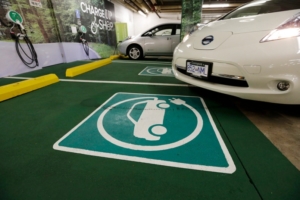Steve Wallace: Transportation’s electric future is here

An electric car pulls into one of the Bay Centre’s charging stations in the parking garage. The future of transportation is electric, Steve Wallace writes, and it’s accelerating fast.
In the early 2000s, I got a chance to tour a Toyota manufacturing plant in Japan. The place was spotless. It was the first thing I noticed upon entry to the facility. My tour group was stellar: The governor of Hokkaido, a famous industrialist, my host, the mayor of Shiraoi, and of course the invaluable translator. As we were led from place to place in the facility, it was explained to all of us that there were no photo opportunities afforded to visitors, but it was, given the small group, a VIP tour experience.
The facility was manufacturing the first generation of the Prius. I was impressed with the vehicle, and asked our tour guide to query as to its suitability for the driving school business. He told me to save my money and wait for a year and a half, when the second generation would be coming off the assembly line. He called it the super car and predicted it would be a game changer for the industry. He was right.
Today, no matter what the product or the dealership, they can’t get enough fully electric models in stock. I had a chance meeting with the owner of the local Kia dealership. He told the same story: Can’t get enough of them. They hit the lot and they are gone in no time. Virtually every dealership in business is in the same boat. North American manufacturers are in the same boat.
I drove the Chevy Bolt. It was very impressive. With the price of gas at the highest level ever recorded, there is a renewed interest in all electric products. Virtually every manufacturer is now responding to the unofficial Tesla challenge of years ago.
Don is one of the salespeople I have had the pleasure to deal with for over a decade. He drives a modern combination battery-to-gas hybrid vehicle, which gets about 40 kilometres on battery power before it switches to gas consumption. He has not had occasion to use any gas for several months. He might have to employ an additive to make sure the fuel does not lose its punch, for lack of use over extended time. This is commonly referred to as tired gas, lacking the initial octane quality.
Only a few years ago, many automotive experts were predicting it would take another decade for electrics to command the market. They have all had a not-so-recent change of mind. The charging stations for such vehicles are sorely lacking. It is easy to predict there will have to be a considerable catch-up period of charge-station construction and availability.
The first all-electric Tesla cab company is now a reality in our Vancouver Island marketplace. All sorts of transportation businesses are now in catch-up mode. Cab companies have always led the way in being accepting of new technology.
The future is now. Ferry fleets are now embracing electric vessels. Bus companies are matching this move to electric. Even the new types of airplane developments will see electric initiative.
Trains, trams and subway electric options are a present or soon-to-be-possible reality. Some exist in places such as Las Vegas and other tourist meccas. Many airports transfer passengers from one terminal to the next by the use of electric tram power. E-bikes seem to be everywhere.
British Columbia has the most abundant and affordable electric power capability on the planet. The future is bound to be friendly to the province.
Every government- and transportation-related business and industry will have to adapt, and soon, if they expect to be relevant in the very near future.
Steve Wallace is the owner of Joan Wallace Driving School on Vancouver Island. He is a former vice-president of the Driving Schools Association of the Americas, a registered B.C. teacher and a University of Manitoba graduate.


